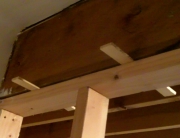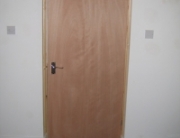A step-by-step beginner’s guide to drywall cutting, hanging and taping with ease.
Time needed to complete project: Varies due to factors such as size of job and the drying time of the joint compound you are using
Tools and Materials Needed
• Drywall sheets
• Mud pan
• Paper or mesh drywall tape (paper tape is preferred)
• All-purpose joint compound or a dry mix, or both
• Drywall T
• Tape Measure
• Utility Knife (make sure the blade is very sharp)
• Keyhole saw
• Power drill or cordless screwdriver with a Phillips bit
• Drywall screws
• Safety glasses
• Drywall knives of varying sizes
Step-by-Step Instructions
Cut Drywall
1. (Using the top of the drywall as a gauge), determine the size of the drywall piece that you need, and mark the spot by making a small cut with your utility knife.
2. Line the drywall T up with your mark. It will be self-leveling because the top of the T is lined up with the top of the drywall piece.
3. Use your foot to hold the T in place at the bottom, and begin to make your cut. Keep in mind that you are not trying to cut through the drywall itself, only the paper, so it will not require a lot of pressure. Make the cut about halfway down, and then complete the cut by cutting from the bottom up.
4. Go around to the back side of the drywall.
5. Put your knee up against the back of the drywall, right where the line is on the other side. Grab both sides of the drywall and snap both sides towards you.
6. Next, using your utility knife, begin making the final cut. Start from the bottom and cut from the bottom up, about halfway. Then finish the cut from the top down.
Making a cut in the center of drywall (such as for an opening for a utility box)
7. Mark the area that you want to cut with a pencil.
8. Using your utility knife, score the drywall where the opening will be.
9. Start making the cut with your keyhole saw by puncturing the drywall with the saw in one of the corners of the box.
10. Saw 3 sides of the box. It is unnecessary to saw the 4th side, as you can just give the center of the drywall a tap, and the square of drywall will fall down. You can then cut the back with your utility knife.
11. Clean up the jagged cuts that you made with your utility knife by scraping it along the opening. You will need a very sharp blade to do this effectively.
Hanging the Drywall
12. Mark the drywall in the center of the stud with a pencil.
13. Line up your drywall T with the mark, and draw a line with a pencil all the way from the top to the bottom of the sheet of drywall.
14. Note: You will want to lay the drywall sheet horizontally, as this uses less drywall overall.
15. Using a power drill or cordless screwdriver and drywall screws, begin attaching the drywall along the line that you’ve made. Be careful to ensure that you don’t rip the paper. Your goal is to slightly countersink the screws (where the head of the screw is slightly indented from the surface) but NOT rip the paper.
16. Staggering the joint. What this means is that you don’t want to line up the ends of the drywall. The reason for staggering the joint is that if you should get a crack in the drywall or some settling, you don’t want the crack to extend from the ceiling to the floor. Staggering the joints will prevent this.
Taping the Drywall
(Note: The terms “joint compound” and “mud” are interchangeable for the purposes of this job)
17. Making a “hot mix” with dry joint compound. (Note, if using an all-purpose pre-mixed joint compound, skip to step #18). Add the water to the mud pan first, and then the mix. Mix it up with one of your knives. The correct consistency will look like thick icing for a cake. Make adjustments to ensure you have the correct consistency.
18. Mesh tape. Although paper tape is preferred, if you have mesh tape, here is the process for applying it: Lay the tape along the drywall seam, starting in one corner and going to the other. The advantage of mesh tape is that it is self-sticking, while we will need to lay a bedding coat for the paper tape.
19. Applying the first coat (paper tape). Lay a bedding coat of joint compound. Apply a coat of joint compound to the seam. Move your knife in a horizontal motion to avoid applying too much compound. Then just lay it down. Next, apply the paper tape, starting in one corner and moving across. Then lay down the tape into the mud by moving your tool across it. Then do the same with a larger tool.
20. Cover the screw heads with mud. You only need a little bit of mud. You will need to ensure that your screws have all been countersunk (see step #15). If you come across one that isn’t, use your screwdriver to countersink it.
21. Mix up your second batch of mud. This one should be just slightly looser than the first batch.
22. Using your tool, “knock down” the high spots where the first coat has dried with rough edges by scraping the edge of the tool across the dried mud.
23. Apply the second coat of mud. Ideally, it should be spread out beyond the borders of the first coat. Lay it down with your large knife, applying just a bit of pressure to the back of the blade as you draw it across the mud. Clean up the edges.
24. Apply the second coat to the screw holes as well.
25. Butt Joint. A butt joint is where two pieces of drywall come together, and it isn’t a tapered edge. Apply a small amount of joint compound to the joint. Apply your tape to the joint, and lay it down with your knife. Keep in mind that less (joint compound) is more here.
26. Apply a second coat to the butt joint.
27. Third and final coat. Run your knife over all the joints to ensure that there are no dry particles or raised pieces. Lay on the final coat of mud, making sure it is spread out beyond the edges of the second coat. Run your large knife across to lay it down, applying just a slight amount of pressure. Keep in mind that you only need a very light coat for the final coat, so lay it on thin.
28. After the 3rd coat dries, sand everything, and you will be good to go!
By See Jane Drill, Copyright 2014





The video for drywall taping for beginners guaranteed professional results is very good. I am a woman and I was a little afraid but I am going to give it a try. My basement was waterproof and they had to remove some of the drywall but would not replace it, so I have to replace it myself or hire someone to do it. I choose to save my money and try to do it myself along with my sixteen year old grandson. I will let you know how it turns out.
Hi Laura, Good luck with your project! Sounds like it will be fun to do it with your grandson. Let us know if you have any additional questions!